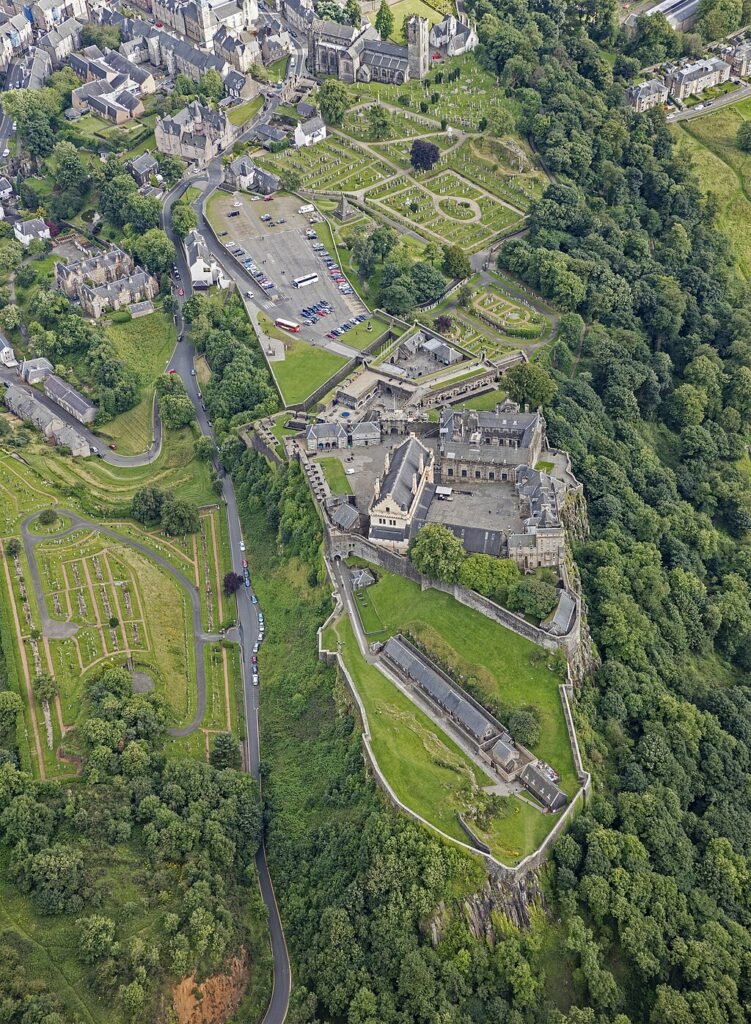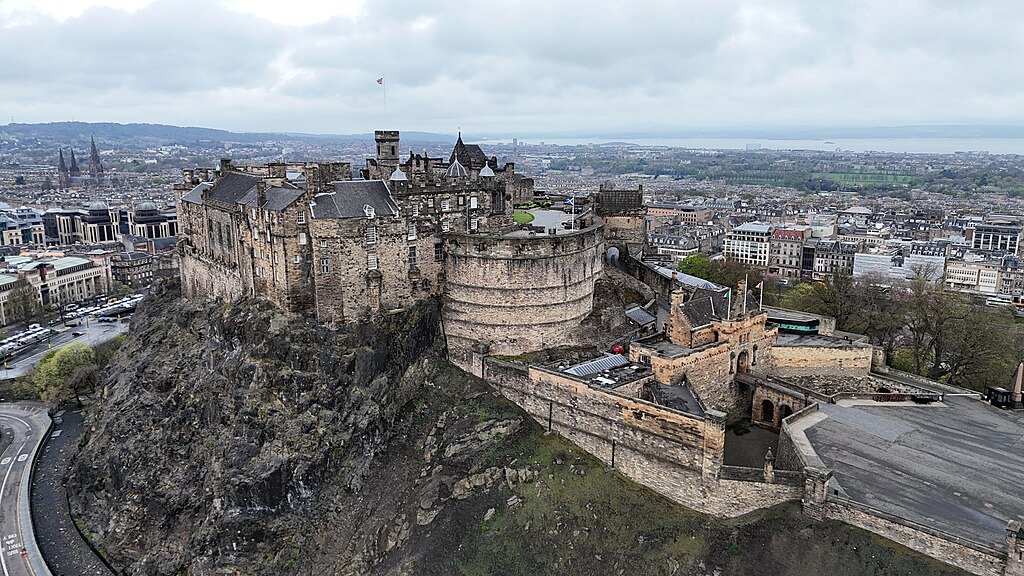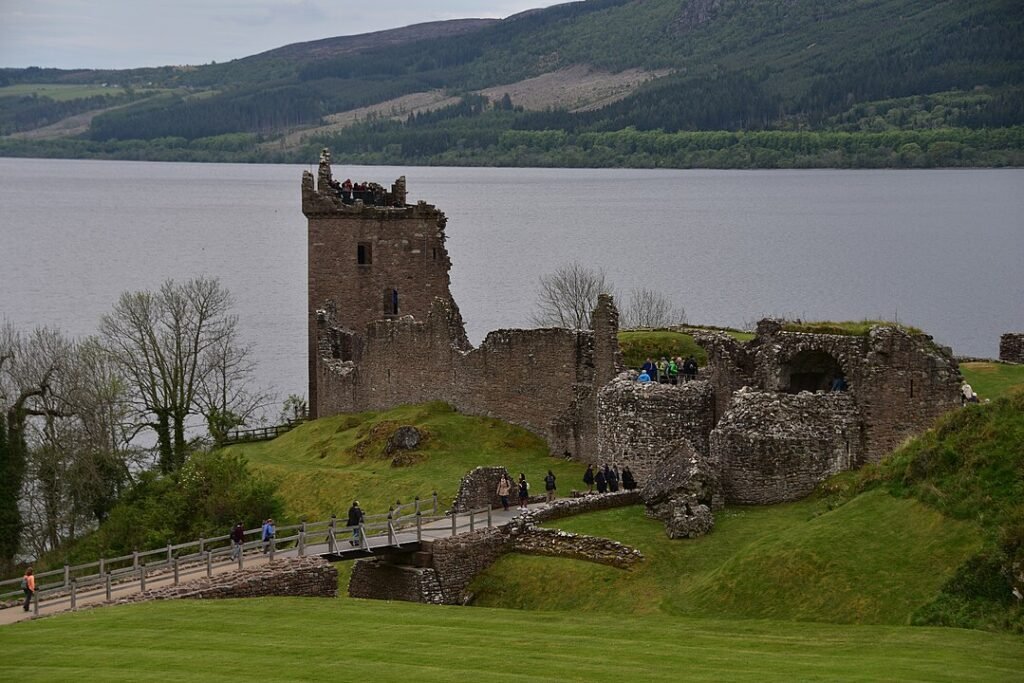
Dunvegan Castle doesn’t just look like a storybook stronghold on the shores of Loch Dunvegan; it has been a lived-in home for eight centuries. Seat of the Chiefs of Clan MacLeod, it blends medieval muscle with Victorian romanticism, wild coastal scenery with unexpectedly lush gardens, and folklore with very real wildlife. If you’re planning a Skye itinerary, this is the castle that rewards you with more than a photo stop: you can explore the state rooms, stroll five acres of gardens, spot seals by boat, and still be within easy reach of Neist Point and Coral Beach.
This guide covers history and highlights, practical visiting advice, itineraries, nearby food and stays, and how Dunvegan fits into wider UK travels – written for families, couples, and solo travellers in UK English.
A short history with long roots – Dunvegan Castle
Dunvegan’s core dates to the 13th century, when a curtain wall and tower house rose from the rock above the sea loch. Over the centuries, MacLeod chiefs added and remodelled, culminating in a 19th-century makeover that unified the silhouette with mock-medieval flourishes. The point is not just old stones, but continuity: Dunvegan is widely regarded as Scotland’s oldest continuously inhabited castle. Its rooms hold clan treasures, from the medieval Dunvegan Cup to Sir Rory Mor’s Horn and, most famously, the Fairy Flag, a tattered silk that legend says can protect the clan in times of need. Whether you come for architecture, objects, or origin myths, Dunvegan’s story reads like a condensed history of the Highlands.
What to look for inside
- The Fairy Flag: Displayed with context that spans Norse and Gaelic tradition, it’s one of Scotland’s most intriguing artefacts.
- The Drawing Room & Library: Portraits and memorabilia bring chiefs and Skye society to life.
- The old pit dungeon: A reminder that “romance” and “rough justice” once shared a wall.
Dunvegan Castle: Quick facts & figures
- Where: One mile north of Dunvegan village, north-west Skye, overlooking Loch Dunvegan.
- Open season: 1 April–15 October (gardens and castle); hours vary slightly in season; last entry typically late afternoon.
- No need to pre-book: Tickets are sold on arrival.
- Gardens: About five acres of designed spaces, including the Walled Garden, Water Garden, Round Garden, woodland walks, and a Garden Museum.
- Wildlife: Regular seal-boat trips from the castle’s jetty (seasonal); expect close views of common seals, plus seabirds.
- Accessibility: Historic interiors mean stairs and uneven floors; gardens and facilities offer partial accessibility with designated parking and accessible loos.
- Photography: Non-commercial photography is permitted inside (no flash, selfie sticks or tripods), and the exteriors are glorious at golden hour.
- Family features: A wild wood play area, trails, and gentle garden paths; pushchairs aren’t allowed inside the castle.
Exploring the grounds: five acres of surprises
You don’t expect subtropical flair this far into the Atlantic, yet Dunvegan’s gardens flourish thanks to shelter belts, smart planting, and decades of restoration.
- Walled Garden: Classic borders, a Victorian-style glasshouse, herbs and edibles, and a memorial gazebo – lovely for slow wanderers and macro-photographers.
- Water Garden: Meandering paths over bridges, streams and falls; look for Korean fir cones, rhododendrons and the Chilean firebush in season.
- Round Garden: A series of circular beds and specimen trees framed by views to the loch.
- Woodland & Rhododendron walks: Evergreen corridors when the wind gets up; spring colour is exceptional.
- Playful touches: A willow-tunnel play area and the “Dunvegan Pebble” (a 2.7-ton rotating marble sculpture) keep kids and kid-at-heart adults grinning.
Tip for families: bring a picnic for the loch-edge lawns, then promise the play area if the seal-trip queue gets fidgety.
On the water: seal-boat trips
One of Dunvegan’s great pleasures is swapping castle steps for a clinker boat. Short loch cruises (around 25 minutes) depart from the jetty on a first-come, first-served basis through the main season (roughly April–September), weather permitting. You’ll motor out to a haul-out where common seals bask, often with pups in late spring and summer. Look out for herons and Arctic terns; white-tailed sea eagles are occasionally seen.
How to plan it
- Boats run daylong in settled conditions; queues can spike between late morning and mid-afternoon.
- Flat shoes and a windproof layer make the difference between “bracing” and “brrr”.
- If the water’s choppy, consider gardens first and check back – the jetty team updates conditions.
Practicalities: getting there, tickets, timing, and accessibility
Getting there
- By car: From Portree, it’s ~34 km/21 miles (about 30–40 minutes) via the A87/A850. From the Skye Bridge at Kyle of Lochalsh, allow ~1 hour–1 hour 15 in normal conditions. Roads on Skye are single-carriage and often single-track, build in slack time and use passing places courteously.
- By bus: Stagecoach runs services between Portree and Dunvegan (routes 56/56X/57A variations). Services are limited on Sundays and in winter – check timetables and plan connections if you’re coming from the bridge or Armadale ferry.
- By tour: Day tours from Inverness or Portree often combine Dunvegan with the west coast (Neist Point, Fairy Pools). Handy if you’re car-free.
Tickets & timing
- No advance booking: Buy tickets at the visitor centre. In peak months (late June–August) arrive early or later in the afternoon to dodge tours.
- How long to allow:
- Castle interiors: 60–90 minutes if you like to read the room notes.
- Gardens: 45–90 minutes, depending on the season and photos.
- Seal trip: 25 minutes plus queue time.
- Add a café stop and you’ve got a half-day visit.
Accessibility & family notes
- Mobility: The castle has stairs and some tight turns; the gardens have step-free paths and benches. Accessible parking and toilets are available.
- Pushchairs: Not permitted inside the castle; soft carriers are fine (but note some steep stairs).
- Assistance dogs: Welcome inside; other dogs are welcome on leads in the gardens only.
- Photography: You can photograph inside for personal use, but no flash, tripods or selfie sticks; drones are not allowed.
When to go
- Spring (Apr–May): Azaleas, rhododendrons and longer days; quieter paths and forgiving light.
- Summer (Jun–Aug): Peak colour and boat reliability, but also peak footfall – arrive early.
- Early autumn (Sep–Oct): Fewer crowds; low, honeyed light on the loch is a gift to photographers.
- Winter: The castle is closed, but the estate often hosts Snowdrop Days in February – gardens and café open for charity, a lovely local interlude if you’re on Skye out of season.
What else to see nearby
- Neist Point (30 minutes’ drive): Skye’s classic lighthouse walk across sea-cliff drama; go for sunset if you can.
- Claigan Coral Beach (10 minutes to the car park + a 25–45 minute easy walk): White “coral” (actually bleached maerl) against turquoise water – best at mid-to-low tide.
- Dun Beag Broch (30 minutes): An Iron Age round tower with sweeping views – pair it with a Talisker Distillery tour via Carbost.
- Glendale & MacLeod’s Tables: Flat-topped hills and crofting landscapes west of Dunvegan, quiet, soulful Skye.
- Armadale Castle Gardens & Museum of the Isles (Sleat peninsula): Clan Donald’s story in a subtler climate; a good south-of-Skye day if you’re ferrying via Mallaig.
Itineraries you can actually do
1) One perfect day around Dunvegan (families or easygoing explorers)
08:45 – 10:15 | Arrive early, castle first
Beat the buses and head straight for the state rooms; the Fairy Flag is quieter in the first hour.
10:15 – 11:30 | Gardens loop
Water Garden → Round Garden → Walled Garden; stop for a snack and loos at the MacLeod Tables Café.
11:30 – 12:30 | Seal-boat trip
Aim for late morning when winds are often still. If boats are paused, swap with the next step.
12:45 – 15:00 | Coral Beach stroll
Drive to Claigan (10 minutes), then an easy walk for picnic-perfect views. Keep an eye on tidal times if you’re planning to paddle to Lampay.
15:30 – 17:30 | Neist Point
From Dunvegan village, allow ~30 minutes to the car park. The descent/ascent involves steps – carry toddlers and take it steady.
Dinner: The Old School Restaurant in Dunvegan (book in advance in peak months) or the Fire Restaurant at The Dunvegan for something smoky and modern.
Distance/time guidance: ~50 scenic driving miles total; add buffer for single-track etiquette and photo stops.
2) A 2-day couples’ escape (views, food, and golden light)
Day 1 – Dunvegan & the west coast
- Morning: Castle interiors and gardens at your pace; coffee in the Walled Garden.
- Midday: Seal-boat trip; wander the loch-edge lawns afterwards.
- Afternoon: Drive to Neist Point for the late-day glow.
- Dinner & stay: Celebrate at Edinbane Lodge (Michelin Guide; 4 AA Rosettes) then stay over in one of the lodge’s stylish rooms.
Day 2 – North Skye circuit
- Morning: Loop east via Uig and the Quiraing (short hikes with epic horizons).
- Lunch: Portree harbour.
- Afternoon: Old Man of Storr viewpoint or a gentle coastal wander to Scorrybreac.
- Evening: Return to Dunvegan or continue south for a night at The Three Chimneys restaurant with rooms at Colbost.
3) A solo traveller’s long weekend (public transport-friendly)
Day 1 – Portree base
Arrive by Citylink coach; explore Portree on foot (shops, harbour, viewpoint paths).
Day 2 – Dunvegan by bus
Stagecoach 56/56X from Portree to Dunvegan (check times). Walk to the castle (c. 20 minutes), tour rooms and gardens, and fit in a seal-boat trip if timings permit. Return on the afternoon bus.
Day 3 – Cultural Skye
Head south to Armadale (museum and gardens), or book a guided day tour that covers Fairy Pools and Talisker. End with a seafood dinner back in Portree.
Why it works: With careful timetable checks (and a willingness to walk), Skye can be enjoyed without a car—especially in longer daylight months.
Where to eat near Dunvegan (balanced picks)
- The Three Chimneys (Colbost, 10 minutes) – A Scottish icon: refined, hyper-local menus and rooms; best for a special occasion. Book well ahead.
- Edinbane Lodge (15–20 minutes) – Destination dining with luxury rooms; seasonal tasting menus led by a Skye-born chef.
- The Dunvegan – Fire Restaurant & Rooms (in the village) – Wood-fired cooking, modern Highland flavours, and six comfy ensuite rooms.
- The Old School Restaurant (in the village) – A long-loved local for seafood and classics in a converted schoolhouse.
- MacLeod Tables Café (on site) – Handy for light lunches, kids’ bites and home baking between castle and gardens.
All spots are popular in summer—pre-book dinners where possible; expect walk-in waits otherwise.
Where to stay (budget → boutique)
- Budget B&Bs and guesthouses (Dunvegan village & surrounds): Solid, friendly options within a few minutes’ drive of the castle; look for sea-view rooms along the loch.
- Roskhill House (Dunvegan area): A small guesthouse known for an award-winning, fully vegetarian breakfast – ideal for slow mornings and walkers.
- The Dunvegan: Six rooms above a contemporary restaurant—a practical “park once” base if you want to stroll to supper.
- MacLeod Estate Cottages: Self-catering cottages within or close to the castle grounds – private, atmospheric, and great for families or longer stays.
- Edinbane Lodge / The Three Chimneys: Boutique “restaurant with rooms” experiences for food-led travellers.
Seasonal events & special experiences
- Snowdrop Days (February): Charity open days for the gardens and café – Skye locals love these for a dash of spring while the island slumbers.
- Skye Highland Games (early August): In Portree on The Lump – piping, heavy events, and a community buzz that pairs well with a Dunvegan day before or after.
- Wildlife watching: Peak seal-pup season typically falls late spring to early summer; bring binoculars.
- Golden-hour photography: The classic loch-reflection shot is best on still evenings from viewpoints north of the castle; mornings can be magic too if mist lifts off the water.
Responsible travel on Skye
- Road etiquette: Use passing places, don’t block gateways, and let faster vehicles by.
- Parking: Car parks at Neist Point and Claigan fill fast – arrive early or late, and never park on fragile verges.
- Leave no trace: Take litter with you; beaches and machair are sensitive.
- Book smart: Skye is popular – secure rooms and key restaurants early in summer, and have a rainy-day plan (Dunvegan’s interiors are perfect).
Dunvegan and the bigger UK picture
Love Dunvegan? You’re primed for a castles-and-coast theme across the UK. In Scotland alone, pair it with Eilean Donan on the mainland for cinematic symmetry, or trace clan stories at Armadale Castle in Sleat and Kisimul Castle on Barra (a Hebridean hop via Uig ferry). On the mainland north, Dunrobin shows French-influenced fairytale towers; in Argyll, Inveraray mixes stately home and Highland heritage. South of the border, Bamburgh and Tintagel add English coastal drama; in Wales, Caernarfon and Conwy take you deep into Edwardian fortress design. Think of Dunvegan as your gateway drug to a lifetime of UK heritage travel, each stop stitched together by rail, road and ferry, with food cultures and landscapes that change in a day’s drive.
FAQs (the things people ask before they go)
Is it worth going in if I only want photos?
Yes – by all means enjoy the exterior views, but the Fairy Flag, clan rooms and gardens make a strong case for going inside.
Can I photograph the interiors?
Yes for personal use, but no flash, tripods, or selfie sticks; staff may limit photography in busy areas.
Are the boats suitable for young children?
Trips are short and gentle in settled weather; lifejackets are provided. If anyone’s uncertain, enjoy seal-spotting from shore and save the boat for a calmer day.
How long should I plan?
A half-day is realistic: castle + gardens + café + boat. Add Neist Point or Coral Beach for a full, perfect day.
Final word
Dunvegan Castle is not a ruin to scramble over; it’s a home that welcomes you in, a garden that defies latitude, and a sea-loch alive with seals. Whether you’re here with children, on a romantic detour, or travelling solo by bus, it makes a Skye itinerary deeper and richer. Linger. Look. Then let the road carry you to the next coastal curve.


